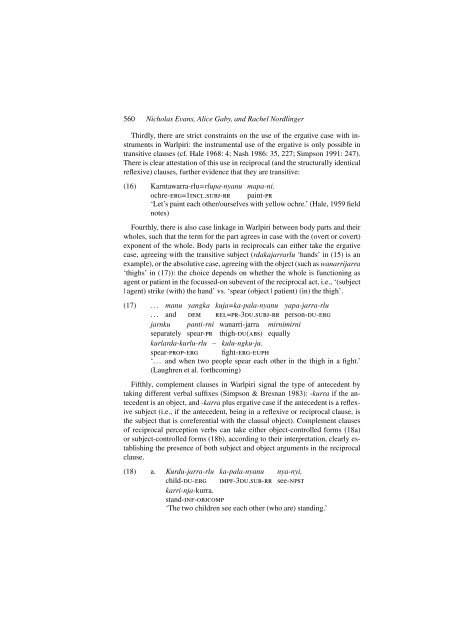Valency mismatches and the coding of reciprocity in ... - Linguistics
Valency mismatches and the coding of reciprocity in ... - Linguistics
Valency mismatches and the coding of reciprocity in ... - Linguistics
Create successful ePaper yourself
Turn your PDF publications into a flip-book with our unique Google optimized e-Paper software.
560 Nicholas Evans, Alice Gaby, <strong>and</strong> Rachel Nordl<strong>in</strong>ger<br />
Thirdly, <strong>the</strong>re are strict constra<strong>in</strong>ts on <strong>the</strong> use <strong>of</strong> <strong>the</strong> ergative case with <strong>in</strong>struments<br />
<strong>in</strong> Warlpiri: <strong>the</strong> <strong>in</strong>strumental use <strong>of</strong> <strong>the</strong> ergative is only possible <strong>in</strong><br />
transitive clauses (cf. Hale 1968: 4; Nash 1986: 35, 227; Simpson 1991: 247).<br />
There is clear attestation <strong>of</strong> this use <strong>in</strong> reciprocal (<strong>and</strong> <strong>the</strong> structurally identical<br />
reflexive) clauses, fur<strong>the</strong>r evidence that <strong>the</strong>y are transitive:<br />
(16) Karntawarra-rlu=rlupa-nyanu mapa-ni.<br />
ochre-erg=1<strong>in</strong>cl.subj-rr pa<strong>in</strong>t-pr<br />
‘Let’s pa<strong>in</strong>t each o<strong>the</strong>r/ourselves with yellow ochre.’ (Hale, 1959 field<br />
notes)<br />
Fourthly, <strong>the</strong>re is also case l<strong>in</strong>kage <strong>in</strong> Warlpiri between body parts <strong>and</strong> <strong>the</strong>ir<br />
wholes, such that <strong>the</strong> term for <strong>the</strong> part agrees <strong>in</strong> case with <strong>the</strong> (overt or covert)<br />
exponent <strong>of</strong> <strong>the</strong> whole. Body parts <strong>in</strong> reciprocals can ei<strong>the</strong>r take <strong>the</strong> ergative<br />
case, agree<strong>in</strong>g with <strong>the</strong> transitive subject (rdakajarrarlu ‘h<strong>and</strong>s’ <strong>in</strong> (15) is an<br />
example), or <strong>the</strong> absolutive case, agree<strong>in</strong>g with <strong>the</strong> object (such as wanarrijarra<br />
‘thighs’ <strong>in</strong> (17)): <strong>the</strong> choice depends on whe<strong>the</strong>r <strong>the</strong> whole is function<strong>in</strong>g as<br />
agent or patient <strong>in</strong> <strong>the</strong> focussed-on subevent <strong>of</strong> <strong>the</strong> reciprocal act, i.e., ‘(subject<br />
| agent) strike (with) <strong>the</strong> h<strong>and</strong>’ vs. ‘spear (object | patient) (<strong>in</strong>) <strong>the</strong> thigh’.<br />
(17) ... manu yangka kuja=ka-pala-nyanu yapa-jarra-rlu<br />
... <strong>and</strong> dem rel=pr-3du.subj-rr person-du-erg<br />
jarnku panti-rni wanarri-jarra mirnimirni<br />
separately spear-pr thigh-du(abs) equally<br />
kurlarda-kurlu-rlu – kulu-ngku-ju.<br />
spear-prop-erg fight-erg-euph<br />
‘. . . <strong>and</strong> when two people spear each o<strong>the</strong>r <strong>in</strong> <strong>the</strong> thigh <strong>in</strong> a fight.’<br />
(Laughren et al. forthcom<strong>in</strong>g)<br />
Fifthly, complement clauses <strong>in</strong> Warlpiri signal <strong>the</strong> type <strong>of</strong> antecedent by<br />
tak<strong>in</strong>g different verbal suffixes (Simpson & Bresnan 1983): -kurra if <strong>the</strong> antecedent<br />
is an object, <strong>and</strong> -karra plus ergative case if <strong>the</strong> antecedent is a reflexive<br />
subject (i.e., if <strong>the</strong> antecedent, be<strong>in</strong>g <strong>in</strong> a reflexive or reciprocal clause, is<br />
<strong>the</strong> subject that is coreferential with <strong>the</strong> clausal object). Complement clauses<br />
<strong>of</strong> reciprocal perception verbs can take ei<strong>the</strong>r object-controlled forms (18a)<br />
or subject-controlled forms (18b), accord<strong>in</strong>g to <strong>the</strong>ir <strong>in</strong>terpretation, clearly establish<strong>in</strong>g<br />
<strong>the</strong> presence <strong>of</strong> both subject <strong>and</strong> object arguments <strong>in</strong> <strong>the</strong> reciprocal<br />
clause.<br />
(18) a. Kurdu-jarra-rlu ka-pala-nyanu nya-nyi,<br />
child-du-erg<br />
karri-nja-kurra.<br />
impf-3du.sub-rr see-npst<br />
st<strong>and</strong>-<strong>in</strong>f-objcomp<br />
‘The two children see each o<strong>the</strong>r (who are) st<strong>and</strong><strong>in</strong>g.’

















